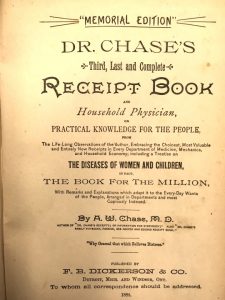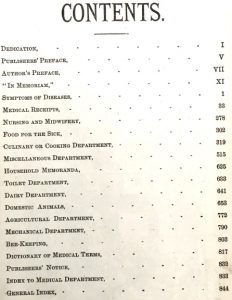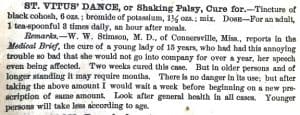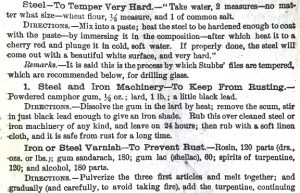Dr. Chase’s Third, Last and Complete Receipt Book and Household Physician
By John Marks, Curator of Collections and Exhibits

Every American generation has looked for advice. Today it’s in our pockets on a phone. It used to be in magazines and books. (How many of you or your parents used Dr. Spock’s Baby and Child Care book?) The reason for seeking advice remains the same: should I call someone or can I take care of this problem myself?
Last month my “new” find in the archives vault was the Church Home Hospital ledger. This month I found Dr. Chase’s Third, Last and Complete Receipt Book and Household Physician, printed in 1888.

Dr. Alvin Wood Chase
Dr. Alvin Wood Chase (1817 – 1885) was born nearby in Cayuga County. The publisher’s “In Memoriam” leaves out large parts of the doctor’s life. He didn’t study medicine until almost the age of 40, graduating from the Eclectic Institute of Cincinnati. (Geneva physician Dr. Ethelbert Padgham graduated from the Eclectic Medical College, the successor school.) Eclectic referred to the practice of choosing whatever would help the patient – botanicals, physical therapy, or drugs.
Eclectic describes Dr. Chase’s books. His first was, Dr. Chase’s Recipes Or Information For Everybody (1866) and the second was Dr. Chase’s Family Physician, Farrier, Bee Keeper and Second Recipe Book (1873). The contents of his final book covered everything from midwifery to mechanics.
 Names of diseases and remedies are unfamiliar to modern readers. St. Vitus’ Dance is Sydenham’s chorea, a reaction to childhood infection. Black cohosh is the flower Actaea racemose, used for centuries to treat nervous disorders and cramps. Bromide of potassium was prescribed as an anti-convulsant and sedative in the late 1800s and early 1900s.
Names of diseases and remedies are unfamiliar to modern readers. St. Vitus’ Dance is Sydenham’s chorea, a reaction to childhood infection. Black cohosh is the flower Actaea racemose, used for centuries to treat nervous disorders and cramps. Bromide of potassium was prescribed as an anti-convulsant and sedative in the late 1800s and early 1900s.

People have used varieties of caustic chemicals to remove warts, moles, and freckles. The advice to use nitrate of mercury wasn’t unusual at the time. Mercury, arsenic, cyanide, and other toxic chemicals were common remedies used by doctors and sold as patent medicines. If you find old medicine bottles with pills, powder, or liquid it’s safest to treat them as hazardous materials.
 Much of Dr. Chase’s advice was copied from other people’s writings or from letters sent to him. Has anyone heard of the “orange cure”?
Much of Dr. Chase’s advice was copied from other people’s writings or from letters sent to him. Has anyone heard of the “orange cure”?
The Mechanical Department had recipes for preventing rust and making things work better.

As you ask Alexa, Siri, or another voice-activated Internet device to get information for you, think how your grandparents (or greats or great-greats) got their answers. If you’d like to see more for yourself, the 1873 edition of Dr. Chase’s book is available online.
Other curator “finds” The Church Home ledger and Geneva’s Gallant Sons.

Thank you for posting a link to the 1873 edition of Dr. Chase’s book. Very interesting! I had never heard of the doctor before, but recently came into possession of his Third, Last, and Complete book, which is very crispy and fragile ( but came complete with some pressed flowers from who knows when!). I’m glad I discovered your site when I googled Dr Chase’s name. Thank you!
I also have this book. Mine is also delicate.
check out the Mince Pie guidelines.
As a person working in Complimentary Alternative Medicine as an herbalist, I treasure my copy of this glimpse in time of an Eclectic. I found my copy in 2012 at an antique store in Maine that was
going out of business. I believe I bought it for 10 cents!
I have a book that was my grandfather of this doctor and the 1867 is the date on the inside
This is my great grandfather! I have some originals of his books and loved reading your information. Thank you!
to Melanie Blanden,
There is a family story that my great great grandfather, who lived to be one hundred years old, worked with Dr. Chase. I don’t know what his role was, and if he helped form the book. I just ordered a copy today to find out.
i have a copy of this book except on the front page it says Receipts and on the spine it says recipes. not sure if this is a spelling mistake or meant to be. must be worth something though
Receipt was a more common term than recipe at one time. There is an interesting account of the connection of receipt and recipe to both cooking and prescriptions in this post on Merriam-Webster.com: https://www.merriam-webster.com/words-at-play/recipe-vs-receipt-usage-word-history
Would love to get my hands on some of these books if possible. Please contact me if you have some original copies that you are willing to sell. Contact me at bruninha12x@hotmail.com
I have a copy found in a basement of a house we rented. It is very delicate. As well not in the best of condition if there are any interested plz message me.
I just found a copy at my dad house who died 5 years ago. Excited to read some of the old receipt.
I’ve had a copy i got from my grandma so long ago. In frail condition and the binder is missing. Very in depth considering the time of publishing.. Amazing.
My great grandfather sold copies of the book in 1902-1903 in southern Wisconsin. He used his earnings to pay for college tuition.